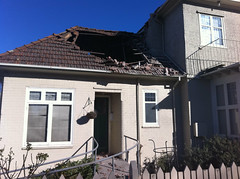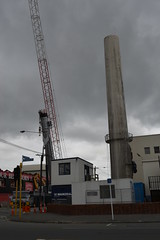
Search
Images for chimney; more images...
BeckerFraserPhotos February 2011 photograph 307
Images, UC QuakeStudies
The collapsed chimney of a property on Robson Avenue in Avonside. It has fallen on to the property's front lawn as a result of the 4 September 2010 earthquake.
QuakeStory Photo 692
Images, UC QuakeStudies
A photograph submitted by Caroline Oliver to the QuakeStories website. The description reads, "Demoilition of one of the 2 damaged chimneys, Cashmere hills 1920 weatherboard house, in March 2011.".
QuakeStory Photo 694
Images, UC QuakeStudies
A photograph submitted by Caroline Oliver to the QuakeStories website. The description reads, "Demoilition of one of the 2 damaged chimneys, Cashmere hills 1920 weatherboard house, in March 2011.".
QuakeStory Photo 693
Images, UC QuakeStudies
A photograph submitted by Caroline Oliver to the QuakeStories website. The description reads, "Demoilition of one of the 2 damaged chimneys, Cashmere hills 1920 weatherboard house, in March 2011.".
QuakeStory Photo 691
Images, UC QuakeStudies
A photograph submitted by Caroline Oliver to the QuakeStories website. The description reads, "Demoilition of one of the 2 damaged chimneys, Cashmere hills 1920 weatherboard house, in March 2011.".
QuakeStory Photo 690
Images, UC QuakeStudies
A photograph submitted by Caroline Oliver to the QuakeStories website. The description reads, "Demoilition of one of the 2 damaged chimneys, Cashmere hills 1920 weatherboard house, in March 2011.".
BeckerFraserPhotos June 2011 photograph 369
Images, UC QuakeStudies
Damage to a house in Redcliffs. The chimney is still intact, but is leaning away from the house at an extreme angle, and concrete blocks have fallen from the walls.
Bike Ride in the East Side - Photograph 14
Images, UC QuakeStudies
A man walks towards a damaged house in Dallington. The chimney has fallen, and roofing tiles have shaken loose. In the foreground, the railings of the damaged Dallington Bridge are visible.
QuakeStory Photo 278
Images, UC QuakeStudies
A photograph submitted by Grant Fife to the QuakeStories website. The description reads, "September Quake. Cranmer Court apartments 05/09/2010. The building is quickly supported while damaged chimneys are removed.".
QuakeStory Photo 741
Images, UC QuakeStudies
A photograph submitted by Tim Kerr to the QuakeStories website. The description reads, "I had assured Lois that we would be safe from falling chimneys about 3 weeks before the September Quake..".
BeckerFraserPhotos May 2011 photograph 0758
Images, UC QuakeStudies
Photograph captioned by BeckerFraserPhotos, "View towards Provincial Council Chamber roof in Durham Street taken from Oxford Terrace".
BeckerFraserPhotos May 2011 photograph 0759
Images, UC QuakeStudies
Photograph captioned by BeckerFraserPhotos, "View towards Provincial Council Chamber roof in Durham Street taken from Oxford Terrace".
Photograph by Neil Macbeth 534
Images, UC QuakeStudies
A view from the corner of Worcester and Montreal Streets to the Untouched World shop in the Arts Centre. Masonry from the building has collapsed onto the footpath below.
Photograph by Neil Macbeth 533
Images, UC QuakeStudies
A view from the corner of Worcester and Montreal Streets to the Untouched World shop in the Arts Centre. Masonry from the building has collapsed onto the footpath below.
BeckerFraserPhotos June 2011 photograph 370
Images, UC QuakeStudies
Damage to a house in Redcliffs. There are large cracks in the concrete block walls and several blocks have fallen. The chimney is still intact, but is leaning away from the house at an extreme angle.
BeckerFraserPhotos June 2011 photograph 371
Images, UC QuakeStudies
Damage to a house in Redcliffs. There are large cracks in the concrete block walls and several blocks have fallen. The chimney is still intact, but is leaning away from the house at an extreme angle.
BeckerFraserPhotos February 2011 photograph 252
Images, UC QuakeStudies
An earthquake-damaged house on Acland Avenue in Avonside. Its chimneys have collapsed and have been weather proofed with tarpaulins. The overgrown garden suggests the house has been unoccupied since the 4 September 2010 earthquake.
Jim Baltaxe WEMO Photograph 037
Images, UC QuakeStudies
A photograph of a member of the New Zealand Army on the roof of an earthquake-damaged property in Christchurch. A tarpaulin has been placed over a hole in the roof caused by the collapsed chimney.
BeckerFraserPhotos June 2011 photograph 461
Images, UC QuakeStudies
Damage to a block of flats on the corner of Gayhurst Road and Locksley Avenue. A chimney has fallen, and tiles have shaken loose from the roof. In front of the property a low brick wall has collapsed.
BeckerFraserPhotos February 2011 photograph 334
Images, UC QuakeStudies
A house on Acland Avenue in Avonside that has been abandoned due to damage from the 4 September 2010 earthquake. The house's front garden has become overgrown and weeds have grown up through the cracks in its driveway. Its chimneys have collapsed and have been weather proofed with tarpaulins.
UC Restarts - Photograph 29
Images, UC QuakeStudies
A crane beside the boiler chimney in the University of Canterbury's Facilities Management yard. The photographer comments, "The University restarts its teaching, and the techies in e-learning move out of NZi3. Inspection and repairs to the University's boiler system. It's getting cooler, we'll need heat soon - but we need accessible buildings first".
Experimental evaluation of the role of slenderness in seismic behaviour of…
Research papers, The University of Auckland Library
Observations in major earthquakes have shown that rockable structures suffered less to no damage. During rocking, that is, partial and temporary footing separations, the influx of seismic energy is interrupted and thus the impact of the base excitation is reduced. Rocking causes the structure to deform more rigid like. Consequently, the structure experiences less deformation along the height and thus a lower damage potential. Although many researchers have studied the influence of rockable footings, most of these are either analytical or numerical, and only a very few structures have been built with rockable footings worldwide, for example, the chimney at Christchurch Airport and the South Rangitikei Viaduct in New Zealand. Despite these studies, a thorough and understanding is not yet available, especially with respect to experimental validations. This work is the first to investigate the rocking behaviour of bridges with different slenderness using large‐scale shake table experiments. To limit the number of influence factors, a stiff footing support and the same fixed‐base fundamental frequency of the bridges were assumed. The result shows that the girder displacement and the footing rotation of the tall bridge do not always move in phase, which cannot be observed in the short bridge. The results demonstrate the important role of slenderness in the overall responses of rockable bridges. This behaviour cannot be observed in bridges with a commonly assumed fixed base since the slenderness effect cannot be activated.


